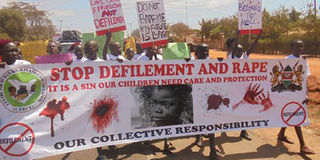Premium
Assessment into factors aiding sexual violence

School children match in Mwingi town on August 31, 2016 to condemn rising cases of defilement. FILE PHOTO | BENEDICT MUTUKU | NATION MEDIA GROUP
What you need to know:
- Although many of these children are treated, only a small fraction of the cases reach the courts and end in convictions.
- In fact, the statistics show that three in 10 assaults occur in the environment that is familiar to the survivors.
Tens of children across the country are still suffering horrific sexual abuse, but their attackers are roaming free because of hurdles placed on the road to justice.
Investigations by the Saturday Nation show that the children aged between two and 12 are more likely to be attacked by their next door neighbours, house helps, or in some cases, their own parents.
Although many of these children are treated, only a small fraction of the cases reach the courts and end in convictions.
In Mombasa, for example, statistics show that this year, so far, some 471 cases of sexual violence have been reported to the Gender Based Violence Recovery Centre (GBVRC) at the Coast General Provincial Hospital (CPGH). Three out of four are children.
A majority of the cases occurred in Kisauni (250), Changamwe (117), Likoni (97), Island (57), Mtwapa (7).
Kisauni has the highest number of victims yet the OCPD, Mr Richard Ngatia, says that in the past three months, only nine cases have been reported to the station and are currently before court.
The Sister-in-Charge at the CPGH, Ms Saida Mwinyi, said the attacks are rarely reported in time as they are “not considered an emergency”.
She said: “Some of the cases we handle are not fresh but are brought here after the parent notices their child has a smelly discharge or cannot sit properly.
"Already, the psychological toil of the violent sexual act has damaged the child. We should not be quiet about such violence.”
The silence is due to the shame and fear of stigma, according to her, but some parents simply do not have the money to take their children to hospital or pursue justice.
This means that many of the culprits are roaming free to commit these crimes again and again.
In fact, the statistics show that three in 10 assaults occur in the environment that is familiar to the survivors.
DEFILEMENT CASES
Sadly, these children fear telling their parents about the attacks and, thus, delay in seeking medical attention, in turn, get sexually transmitted infections such as gonorrhoea and HIV, while the girls in addition to these infections, end up pregnant.
In Nairobi, most defilement cases are reported in Eastleigh, Embakasi (Tassia), Mukuru Kwa Njenga, Kayole, Soweto, and Dandora, according to data collected at the police surgery unit.
Dr Kizzie Shako, a police surgeon at the unit, but seconded to the National Police Service, says she attends a “minimum of six to up to 14 new cases of defilement” every day from the areas.
Dr Shako told the Saturday Nation: “Most of the cases I handle are of children who were left behind with a neighbour as their parents went to look for work but instead, these guardians sexually violated them.
"In other cases, the children were playing outside unsupervised and they were lured with money and food, while in some cases, the teenagers are lured by DVDs or movies while others, are kidnapped.”
She says cases of sodomy in younger boys are mostly from institutions such as schools, and children’s homes, perpetrated by “care givers, older boys, and street men”.
According to her, most children aged between 11 and 17 are defiled by their fathers, older boyfriends, as well as pastors, ending up in pregnancies.
In fact, according to a four-year monitoring of Gender Based Violence through the national 24 hours hotline 1195 across the country, Nairobi records the most cases.
However, it is not just children from disadvantaged backgrounds that are at risk, Dr Shako says.
Statistics from the Nairobi Women’s Hospital, known for handling nearly 3,000 sexual violence cases annually, show defilement in children comes second to rape in adults.
In particular, the hospital in its 2015-2016 annual report has noticed an increase of abused minors below five years, who were violated by the house helps and step-fathers.
Ms Dorothy Onditi, the sergeant in-charge of the Gender Desk at Makupa Police Station, Mombasa, says eight in 10 cases they handle a month come from Moroto Slums, in Tudor.
“Once a defilement is reported, we send the victim to Coast General Hospital for medical attention, which covers treatment of injuries and drugs to prevent HIV infections (Post Exposure Prophylaxis), and emergency contraceptive pills, but many cannot afford to pay for a tuk tuk or matatu fare. We step in and give them out of our pocket,” she says.
DELAYS
For those who jump this hurdle, they get stranded when they cannot get the Sh1,500 that is sometimes charged to fill in a P3 Form in a health facility, which is said is meant to “facilitate court appearance of the medical officer”.
The P3 is a Kenya Police Medical Report Form that documents injuries on a survivor following a violent act such as defilement, rape, or assault.
As such it is an exhibit in court. It is filled in two parts, first by the police officer assigned the case, who states particulars and the second by a registered medical officer or medical practitioner.
But many parents do not pursue the matter, as they feel the processes of seeking justice is time consuming and they would rather their children heal and forget it.
But not for Ms Judy Makena (not her real name), a resident of Kwale County whose Class Two child was defiled by a neighbour, a 35-year-old man, barely a month ago.
The Saturday Nation found her at the CPGH last week at 7.30am, as she waited to have her daughter’s P3 form filled in by a medical officer.
“I have been here since 6.30am with my daughter and I found a people queuing to see the doctor to fill in the forms. It is on a first-come, first-served basis. The guard at the door only gave out 30 numbers today,” she said.
“I did not get the number. When I asked for it, the guard asked for ‘his lunch’ so that he could get me one”, she said, tears welling her eyes.
“If it is not signed today (Monday), the next appointment could be on Thursday. I want to get justice for my daughter that is why I will wait but I have spoken to mothers who gave up and went back home with their children,” she added.
Ms Makena managed to get the help of a police officer, and her child’s P3 form was processed, two weeks after she was raped.
Dr Shako says there has to be better coordination in handling cases of gender-based violence, especially when children are the victims.
“We need to set up a one-stop centre where these cases are reported, treatment including psychological care offered, P3 forms filled and samples collected – all this for free – within the same setting so that we handle these cases better.”
HELP THEM
She believes there is a need to support survivors of gender violence and not blame them, as this only emboldens the perpetrators and increases the vulnerability of these survivors.
The Sexual Offences Act 2006 stipulates that anyone who defiles a child,11 years or less, is liable to a life sentence.
If the child is between 12 and 15 years, the minimum sentence is 20 years.
And if the child is between 16 and 18, the minimum sentence is 15 years.
Ms Angelina Cikanda, the head of the Access to Justice Programme, at the Centre for Rights Education and Awareness, notes that offenders are beating the law.
“Some make a survivor take a shower, to wash away evidence or burn the clothes, so the doctor cannot describe the state of the survivor, how they met, which affects the case as there is no evidence.”
With many survivors not properly supported, the trauma is extreme so that they cannot describe the crime, which helps the perpetrators to evade justice.





